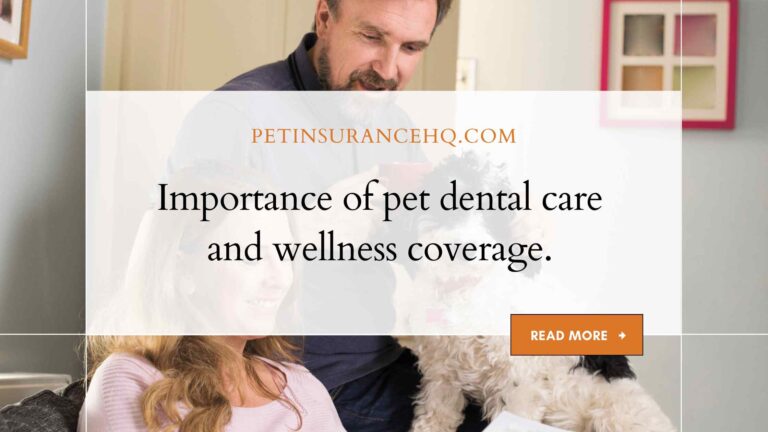How to evaluate the quality of a pet insurance company’s wellness coverage
Searching for the perfect pet insurance company can be a daunting task, especially when evaluating their wellness coverage. With so many options out there, it’s important to know what to look for in order to make an informed decision and provide your furry friend with the best possible care.
In this blog post, we will explore some essential factors that should be considered when assessing a pet insurance company’s wellness coverage – from preventive care benefits to exclusions and limitations. Don’t miss out on our top tips for evaluating the quality of a pet insurance company’s wellness coverage!
What is Pet Insurance and Wellness Coverage?
When it comes to pet insurance, there are two main types of coverage: insurance for accidents and illnesses, and wellness coverage. Wellness coverage is a relatively new addition to pet insurance policies, and it can help reimburse you for routine care expenses like vaccinations, teeth cleanings, and routine bloodwork.
Not all pet insurance companies offer wellness coverage, so if this is something you’re interested in, be sure to do your research before signing up for a policy. In general, we recommend looking for a policy that covers at least 50% of the cost of preventive care services.
When evaluating the quality of a pet insurance company’s wellness coverage, there are a few things you should keep in mind. First, take a look at the list of covered services. Some policies will only cover basic services like vaccinations and routine bloodwork, while others will also cover things like MRI scans and cancer treatment.
Next, check to see if there are any limits on how much you can spend on wellness care per year. Some policies have an annual limit of $500-$1,000 for wellness care, while others have no limit at all. This is important to consider because routine care costs can add up quickly if you’re not careful.
Pay attention to the reimbursement rates offered by the pet insurance company. Most companies will reimburse you 70-80% of the cost of covered services after you’ve met your deductible, but some may offer higher or lower rates.
Factors to Consider When Evaluating Pet Insurance
When it comes to your pet’s health, you want to make sure you’re getting the best possible coverage. Here are some factors to consider when evaluating pet insurance companies’ wellness coverage:
- What is included in the wellness coverage? Make sure to check what services and preventive care are covered under the policy.
- How much does the coverage cost? Compare the premium costs of different policies to find one that fits your budget.
- Does the policy have any exclusions? Be sure to read the fine print of any policy before signing up, so you know what is and isn’t covered.
- Is there a deductible? If so, how much is it? A policy with a higher deductible may have lower premiums, but make sure you can afford the out-of-pocket costs if you need to use the coverage.
- How easy is it to file a claim? Find out what the process is for filing claims and whether you will be reimbursed directly or if the provider will pay the vet directly.
By taking the time to evaluate these factors, you can be sure you’re getting the best possible value for your money when it comes to pet insurance.
Cost of Wellness Coverage
The cost of wellness coverage for pets can vary greatly depending on the type of pet insurance company you choose. Some pet insurance companies offer very comprehensive coverage with a high monthly premium, while others have more basic coverage with a lower monthly premium. It’s important to evaluate the quality of a pet insurance company’s wellness coverage before you decide which one to use.
When looking at the cost of wellness coverage, consider the following:
- The type of coverage the pet insurance company offers. Does it cover routine care, such as vaccinations and check-ups, or does it only cover accidents and illnesses?
- The monthly premium. Is it affordable for your budget?
- The deductible. How much will you have to pay out of pocket before the insurance company starts paying?
- The co-payments. How much will you have to pay for each visit to the veterinarian?
Choose a pet insurance company that offers the right type of coverage for your needs and budget.
Network Availability
One of the best ways to evaluate the quality of a pet insurance company’s wellness coverage is to check its network availability. Make sure the company you’re considering is accredited by the Better Business Bureau and that it has a wide network of veterinarians and pet hospitals in your area. Also, be sure to read the fine print carefully before signing up for any policy, as some companies have restrictions on which veterinarians and hospitals you can use.
Coverage Limits
The typical pet insurance policy has limits on how much the insurer will reimburse for wellness care. These limits are generally expressed as a percentage of the total costs incurred or as a flat-dollar amount per year. For example, a policy might reimburse 80% of the costs of routine care up to a maximum of $1,000 per year.
When considering a pet insurance policy, it’s important to understand what is and is not covered under the wellness portion of the plan. Most policies will cover vaccinations, routine bloodwork and urine tests, spaying/neutering, and annual physical exams. Some also cover microchipping, heartworm testing, and other preventive care measures.
Be sure to read the fine print of any policy you’re considering, as there may be exclusions or limitations on coverage for certain types of procedures or services. It’s also important to compare deductibles, co-pays, and reimbursement levels among different policies to make sure you’re getting the best coverage for your needs.
Pre-Existing Conditions

When it comes to pet insurance, pre-existing conditions are unfortunately not always covered. This is why it’s so important to do your research and evaluate the quality of a pet insurance company’s wellness coverage before enrolling your pet.
There are a few things you can look for when trying to determine if a pet insurance company’s wellness coverage is right for you:
- Does the company have a cap on how much they will reimburse per year for wellness visits?
- Does the company cover routine vaccinations and screenings?
- What type of preventive care does the company cover? (i.e. dental cleanings, spay/neuter surgery, etc.)
- Does the company have any age or species restrictions on their wellness coverage?
If you’re not sure about a particular pet insurance company’s wellness coverage, don’t hesitate to give them a call and ask questions. It’s better to be informed before enrolling your pet than to be caught off guard later on down the road.
Advanced Care Options
Advanced care options are important to consider when choosing a pet insurance company. Some companies offer comprehensive coverage that includes routine, preventive and emergency care, while others only cover emergency care. It’s important to find a company that offers the right mix of coverage for your needs and budget.
When it comes to advanced care options, you’ll want to consider what’s covered and how much it will cost. Some pet insurance companies cover routine care, such as vaccinations and wellness exams, while others only cover emergency care. You’ll also want to find out if there are any restrictions or limits on coverage. For example, some companies may only cover certain types of procedures or treatments.
It’s also important to compare prices when considering advanced care options. Some pet insurance companies charge higher premiums for comprehensive coverage, while others offer more affordable plans that only cover emergency care. Be sure to get quotes from several different companies before making a decision.
Payment & Reimbursement Process
The most important factor to consider when evaluating the quality of a pet insurance company’s wellness coverage is the payment and reimbursement process. Does the company have a simple and straightforward claims process? How quickly does the company reimburse claims?
It’s also important to consider what type of coverage the pet insurance company offers. Does the company cover routine wellness care, such as annual exams, vaccinations, and teeth cleaning? Or does the company only cover unexpected illnesses and injuries?
You’ll want to take a look at the pet insurance company’s customer reviews to see what other pet owners think about their coverage.
Additional Benefits
Be sure to evaluate a pet insurance company’s wellness coverage in addition to their regular coverage. Wellness coverage can help with the cost of routine vaccinations, check-ups, and tests that all furry family members need to stay healthy. Some companies even offer routine care packages that include things like spaying/neutering, teeth cleaning, and more.
Conclusion
Evaluating a pet insurance company’s wellness coverage can seem like a daunting task, but it doesn’t have to be. As long as you take the time to look into each plan’s coverage details and make sure that they match your needs, you should be able to find the best plan for both you and your furry friend. Remember that while most plans offer basic wellness care options, some may include further discounts or even specialized programs designed with your pet in mind. Take the time to explore all of these aspects so that you can make an informed decision on a quality pet insurance policy.







